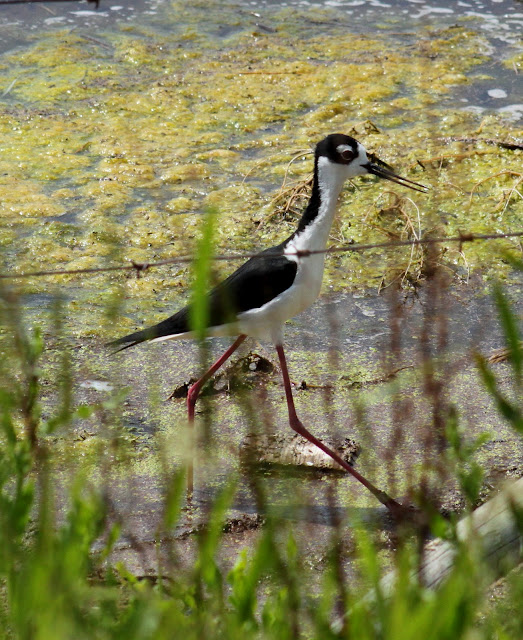Black-necked Stilt (Himantopus mexicanus)
Field notes: Tall slender wading bird, length 35-40 cm/14-16", long spindly reddish legs; black plumage above, white beneath, long straight thin black bill; white over eye. On close inspection the male's back is a glossy black and the female's is slightly less glossy with a brownish tint.
The photo below is of a female; she had a brood of 4 little ones tucked in the grass. A male is behind her, barely seen.
All About Birds tells us:
Black-necked Stilts are closely related to, and often found with, American Avocets. Juvenile Am. Avocets are black + white, and are sometimes misidentified as stilts. Different bill shape is the first clue. (There is an adult Am. Avocet in background below).
They are very vocal birds, issuing a sharp, repeated 'vik!'. Stilts, along with avocets, are a sort of sentinel bird, alerting other birds in the marsh with their noisy calls.
As with most birds, the Black-necked Stilts were hunted almost to extinction in the 19th century. The species was later protected and has recovered to a point where it is locally common across the southern US.
However, they are a bit of a big deal up here in the southern Canadian Prairies, this being their northernmost breeding range limit. If a nesting colony is found, we birding types make an effort to travel the distance to see them. These particular birds were in a loose colony at Channel Lakes near Avonlea, SK.
Most information was from All About Birds (linked above)
Also:
Wikipedia http://en.wikipedia.org/wiki/Black-necked_Stilt
Field notes: Tall slender wading bird, length 35-40 cm/14-16", long spindly reddish legs; black plumage above, white beneath, long straight thin black bill; white over eye. On close inspection the male's back is a glossy black and the female's is slightly less glossy with a brownish tint.
The photo below is of a female; she had a brood of 4 little ones tucked in the grass. A male is behind her, barely seen.
All About Birds tells us:
Black-necked Stilts wade for their food, and will only swim or dive when under duress. During breeding and during winter, they are strongly territorial birds, and are particularly aggressive to chicks that are not their own. When not breeding, Black-necked Stilts roost and forage in closely packed groups, often staying within a foot of each other. Black-necked Stilts are semi-colonial when nesting, and they participate en masse in anti-predator displays. The displays include one in which non-incubating birds fly up to mob predators, and one in which all birds encircle a predator, hop up and down, and flap their wings.About those long reddish/hot pink legs....this species has the second-longest legs (16.5cm/6.5") in relation to the body, exceeded only by flamingos.
Black-necked Stilts inhabit shallow wetlands, salt ponds, flooded lowlands, or shallow lagoons. Human-maintained wetlands such as sewage ponds or flooded pastures are particularly suitable habitats for these birds, since such environments have some sparse vegetation without being too overgrown
Black-necked Stilts wade in shallow waters to capture their meals of aquatic invertebrates and fish. They often consume such fare as crayfish, brine flies, brine shrimp, beetles, water boatmen, and tadpoles. They peck, snatch, and plunge their heads into the water in pursuit of their food, and will herd fish into shallow waters to trap them there
Black-necked Stilts are closely related to, and often found with, American Avocets. Juvenile Am. Avocets are black + white, and are sometimes misidentified as stilts. Different bill shape is the first clue. (There is an adult Am. Avocet in background below).
They are very vocal birds, issuing a sharp, repeated 'vik!'. Stilts, along with avocets, are a sort of sentinel bird, alerting other birds in the marsh with their noisy calls.
Black-necked Stilts nest on the ground. They tend to build on surfaces above water, such as small islands, clumps of vegetation, or even, occasionally, floating mats of algae. Both female and male Black-necked Stilt choose the site; they look for places with soft substrate that can be scraped away to form the depression in which they nest.Male and female Black-necked Stilts trade off the job of constructing the nest. While one mate observes, the other scrapes into the dirt with breast and feet to form a depression about 2 inches deep. As they dig, they throw small bits of lining over their back into the nest. Most lining is added to the nest during incubation, and consists of whatever material is closest to the nest, including grasses, shells, mud chips, pebbles, and bones.
As with most birds, the Black-necked Stilts were hunted almost to extinction in the 19th century. The species was later protected and has recovered to a point where it is locally common across the southern US.
However, they are a bit of a big deal up here in the southern Canadian Prairies, this being their northernmost breeding range limit. If a nesting colony is found, we birding types make an effort to travel the distance to see them. These particular birds were in a loose colony at Channel Lakes near Avonlea, SK.
Most information was from All About Birds (linked above)
Also:
Wikipedia http://en.wikipedia.org/wiki/Black-necked_Stilt
Smithsonian Field Guide to the Birds of North America
National Wildlife Federation Field Guide to Birds of North America





Those Black-necked Stilts are beautiful birds. I've never seen one myself. Guess we'll have to make a trip south to do that. Enjoy seeing the American Avocets, though, up here Melfort way. Great photos and info, Kathy!
ReplyDeleteThanks, Scott. I don't see these stilts every year either. I hope they return to the Channel Lakes location next year - that's about 1 1/2 hours of driving through good birding area, so it is a great day trip for me. Delightful birds to watch.
Delete